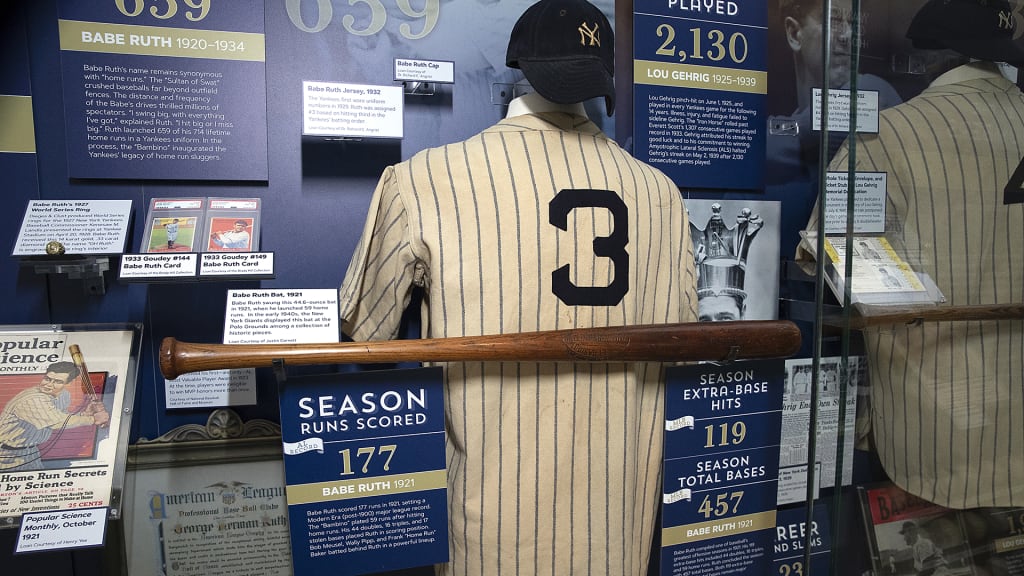
Most professional sports teams find a way to celebrate their history through various programs and initiatives. Whether it’s a Ring of Honor or a patch on a sleeve or larger-than-life photos adorning the walls of a stadium, teams go to great lengths to sustain the memories of the players and teams that helped establish their historic records.
For Yankees fans, their sports DNA includes some of the most iconic moments and figures of all time. Lou Gehrig’s speech, Joe DiMaggio’s streak, Mickey Mantle, Yogi Berra … all will resonate forever among the American sports consciousness, and their legacies all sprouted from Yankee Stadium. Of course, no luminary looms larger than the Great Bambino, Babe Ruth. More than a century has passed since George Herman Ruth arrived in New York, and yet his familiar face still welcomes fans stepping off the subway at 161st Street. Walk around Yankee Stadium, and you won’t have to look hard to find statues, photos, quotes and a monument -- all testament to Ruth’s place in franchise history. But if you want to get even closer to the Colossus of Clout, a visit to the New York Yankees Museum presented by Bank of America is in order.
Working with several of the world’s pre-eminent memorabilia collectors, museum curator Brian Richards has obtained some of the finest Ruth pieces known to exist. Many of the items are currently on display; others are stowed away, waiting to be unveiled as part of a future exhibit or the museum’s Hands On History program. All are incredible. And when you consider the stories behind these items and look at photos of the legend himself using or wearing them, you can’t help but feel a connection to the greatest baseball player of all time.
1921 Bat
Part of what makes the Yankees Museum’s collection so unique is its accessibility: It remains open, at no additional charge, to ticketed fans during every home game, from 90 minutes prior to first pitch through the end of the eighth inning. Before watching Aaron Judge take aim at the bleachers, guests can stroll out toward right field along the Main Level concourse and glimpse the lumber used by another Yankees right fielder 100 years ago.
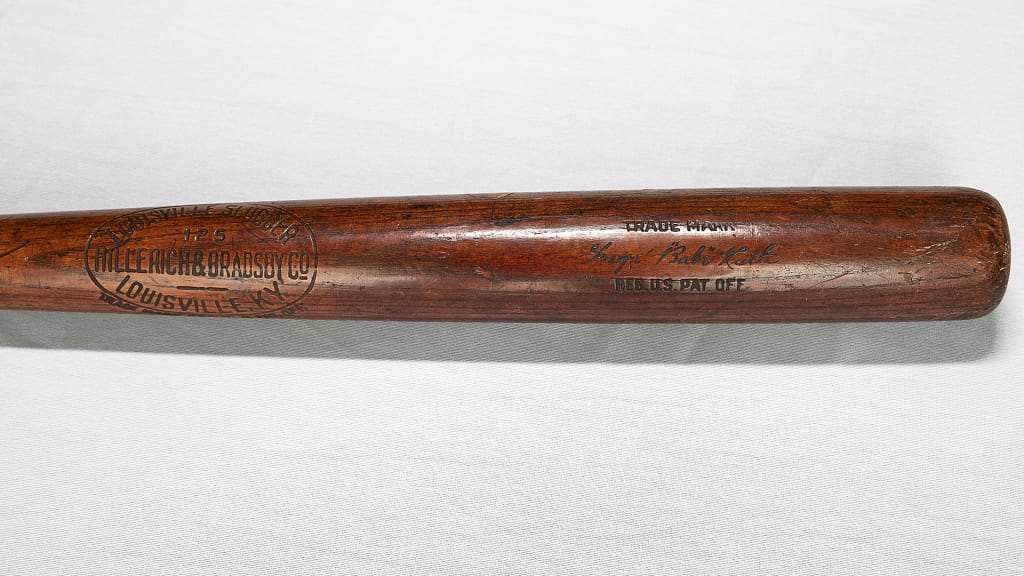
In 1921, Ruth redefined the word “slugger,” batting .378 while leading the majors in a slew of offensive categories, including home runs (59), RBIs (168) and runs scored (177). His 457 total bases -- three per game over 152 -- remains the single-season record. And one of the bats he used to do that damage is housed at Yankee Stadium.
Weighing in at a whopping 44.6 ounces, Ruth’s war club was manufactured by Hillerich & Bradsby in Louisville, Kentucky. Like fingerprints, wood grain patterns are unique to each bat, and eagle-eyed experts were able to determine that the Bambino wielded the bat at the Polo Grounds in 1921.
The backstory, as detailed in a 2020 article on the website Sports Collectors Daily, is that the ash bat was part of a display at the Polo Grounds in the early 1940s featuring game-used equipment. The items were sold off to raise money for charity, and Ruth’s bat was purchased as a gift to a 14-year-old fan as a reward for his hard work during a summer job. The boy held on to the bat for half a century before selling it in 1993. That purchaser parted with it in February 2018, when Houston-based collector Justin Cornett bought it at auction and then loaned it to the museum. “It’s like history,” Cornett told Sports Collectors Daily. “You’re holding the best bat ever used by the best player in his best season.”
1923 Opening Day Home Run Bat
“Some ballyard,” Ruth proclaimed upon first seeing the Yankees’ new home at 161st Street and River Avenue. He later stated that he’d give a year of his life if he could christen Yankee Stadium with a longball, and on Opening Day 1923, he did just that.
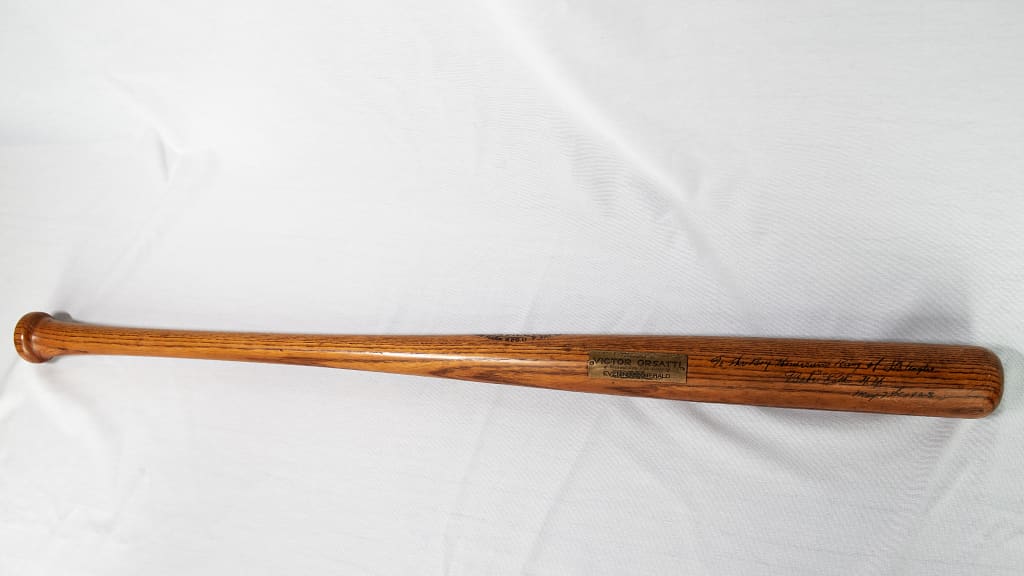
Ruth’s third-inning blast off Red Sox right-hander Howard Ehmke with two runners aboard -- career homer No. 198 -- gave the Yankees a 4-0 lead (they’d go on to win, 4-1) and sent the new park into a tizzy. “Little” Ray Kelly, who served as Ruth’s kid mascot that season, recalled the shot into the right-field bleachers years later in a conversation with former Yankees public relations director Marty Appel.
“When he got his pitch and hit it out, the place went nuts; you couldn’t believe it,” Kelly said. “Babe was tipping his cap as he ran the bases and had this huge smile on his face. We were all jumping up and down in the dugout, throwing our caps up in the air.”
The 36-inch Hillerich & Bradsby bat would not remain with the Babe for long. He had made a promise that he would give his first home run bat of the season to the Los Angeles Evening Herald, so that the newspaper could award it to the city’s high school home run champion. True to his word, Ruth signed it, “To the Boy Homerun King of Los Angeles” and sent it westward. In June, when Victor Orsatti -- who would go on to a long, successful career as a Hollywood agent -- was crowned champion, the Evening Herald adhered a small plate to the bat acknowledging his feat, and Ruth followed up with a telegram that read, “Glad to hear you win Evening Herald home run bat but sorry there was not a trophy for all the boys. In my home-run experience I have found a fellow frequently fails when he tries hardest. Therefore send my regards to the ones who tried and congratulations to you for winning.”
Today, the bat -- on loan from collector Dr. Richard C. Angrist -- rests in a glass case for all to see, just a few hundred yards from where Ruth made his historic swat.
1927 World Series Ring
It is well known that Ruth batted and threw left-handed. Lesser known, however, is that he wrote with his right hand, as evidenced by the slant of his inscription -- “The greatest team of them all” -- on a 1927 team photo. Ninety-four years later, Ruth’s bold claim remains easily defended.
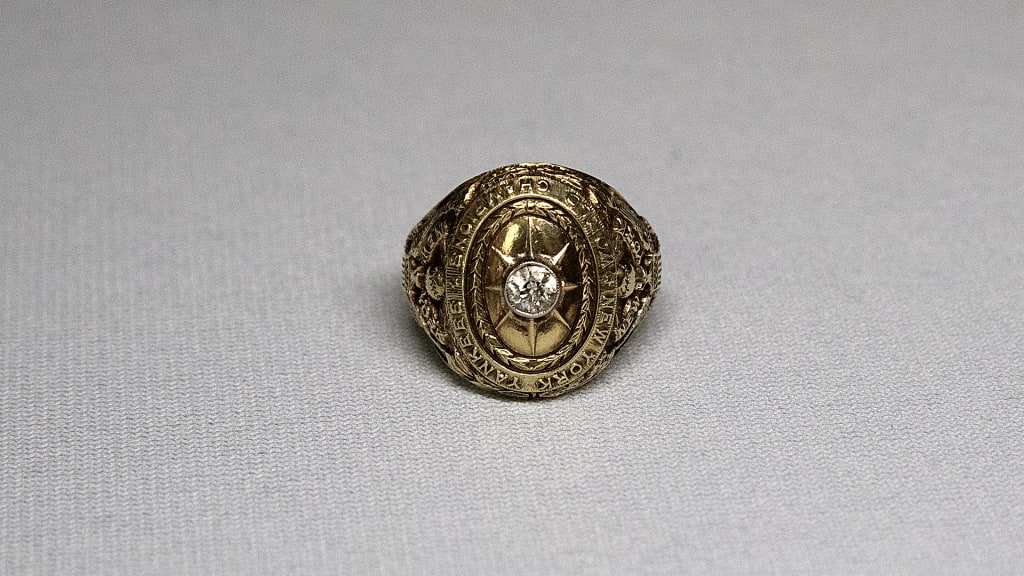
Led by the Colossus of Clout’s record-breaking 60 home runs, the 1927 Yankees went 110-44-1 and won the American League pennant by 19 games, then outscored the Pirates, 23-10, in a four-game World Series sweep. Their .714 regular-season winning percentage remains third in AL history, topped only by the 1954 Cleveland Indians (.721) and the 2001 Seattle Mariners (.716), neither of whom won the World Series.
It is unknown on which hand Ruth wore his ’27 World Series ring, or whether he wore it at all; no photo of him sporting the bauble is known to exist. But the cherished keepsake remained in his possession until his death in 1948, after which his wife, Claire, held onto it until the 1970s, when it was obtained by collector Barry Halper. The actor Charlie Sheen bought it from Halper in the mid-1990s, but in 2017 he decided to sell the ring as well as the original document marking Boston’s 1919 sale of Ruth’s contract to the Yankees.
The 14-karat gold ring was produced by Dieges & Clust, which also made college football’s Heisman Trophy from its 1935 inception through the end of the 1970s as well as Lou Gehrig’s farewell plaque in 1939. Legacy Fine Jewelry Incorporated verified the ring’s authenticity by closely comparing it to 1927 World Series rings that had belonged to Herb Pennock, Benny Bengough and Earle Combs. While those names might not be as familiar as Ruth’s to Yankees fans today, they are part of the reason why critics still cry, “It’s not like they were facing the ’27 Yankees!” whenever a team loses a game to a supposedly inferior opponent.
Late 1920s ‘Notched’ Bat
Babe Ruth captivated the nation in 1927, as he broke his own single-season home run record by clubbing 60 round-trippers. But he also kept things loose, coming up with ways to entertain his teammates throughout the long season.
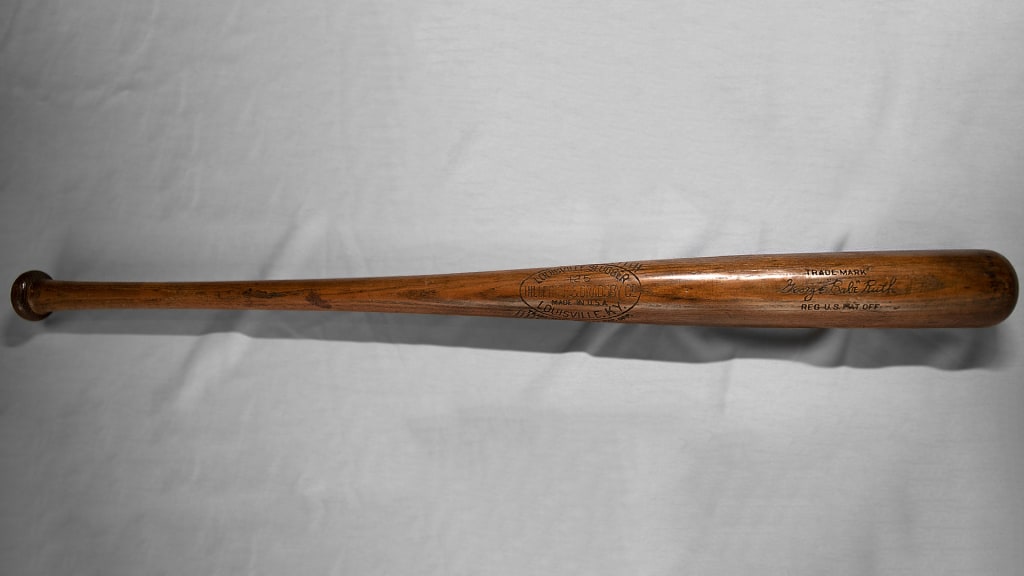
In his 1928 book, “Babe Ruth’s Own Book of Baseball,” Ruth revealed how he started cutting a notch in his bat every time he hit a home run with it, “like the old gunmen used to notch their guns when they killed a man.” It began as a “stunt,” just for laughs, but when the rest of Murderers’ Row saw how far and how often those balls flew out of the park, Ruth’s notched bat became an object of great reverence. He stopped the practice after a few seasons, so this 11-notch bat on loan from Angrist, which was determined by PSA/DNA authenticators Vince Malta and John Taube to have been used in 1928 and possibly early 1929, is one of just five known notched Ruth bats in existence.
“Eleven is about as many as a bat will hold, for the minute you start notching the hitting surface the umpires will throw the bat out,” Ruth wrote. “The whole thing started as a sort of ‘kid’ and as a matter of fact I wasn’t superstitious about those notches at all. But most of the gang thought I was. And I did accomplish one thing: By putting those notches in the bat I identified my own clubs, and the other fellows would leave my bats strictly alone.”
1932 Cap
Authenticating game-worn apparel by matching it to original photos of it being used is a tricky business. It takes a detective’s eye, a historian’s knowledge and the know-how of a forensic scientist. By identifying subtle details -- the position of buttons on a jersey, or the slightest imperfection in the wood of a bat -- experts can verify (or debunk) an artifact’s legitimacy.
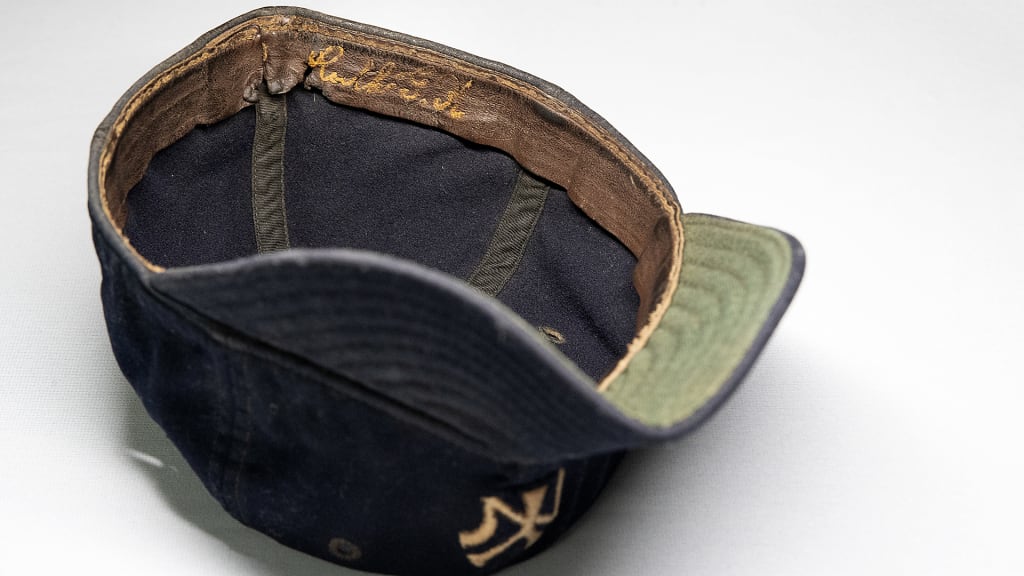
Caps pose a unique challenge in that their exteriors vary little from teammate to teammate, and even from year to year. Their most distinguishing characteristics are found inside, and not too many photographers were going around snapping pics of the interior of players’ ballcaps 100 years ago (or even today, for that matter). So when you get to glimpse the underside of a real Yankees cap worn by the King of Crash, it is a magical sight.
The interlocking ‘NY’ on a dark blue Yankees cap offers a few clues as to when the hat might have been worn; the size and style of the team’s logo has evolved slightly over the decades. But flipping a cap upside down and seeing “Ruth G. H.” stitched into the leather headband makes clear exactly who owned it. One can imagine a sweaty Ruth stuffing the cap in his back pocket (hence the creased brim) as he heads into the Yankees’ dugout along the third-base line at Yankee Stadium after another home run trot around the bases. He then fishes a fresh cabbage leaf from a bucket of ice water to put under the size 73⁄8 cap and help him beat the afternoon heat while patrolling right field in front of the section of stands dubbed “Ruthville.”
1932 Home Jersey
There are only eight authenticated, game-worn Ruth jerseys known to be in existence, according to Richards. Three of them are currently on loan to the Yankees Museum, and this one, owned by Angrist, might be the finest of all.

It is a 1932 home jersey in remarkable condition, confirmed to have been worn by Ruth during the first game of the World Series. No name on the back, obviously. And, as was the case throughout Ruth’s entire career in New York, no logo adorns the front of his home uniform. (The Yankees removed the ‘NY’ from their left breast prior to the 1916 season and didn’t bring it back until 1936.)
A closer examination reveals details that, nearly 90 years later, inspire wonder. On the inside of the collar, stitched (rather imperfectly) in red thread next to the “A.G. Spalding & Bros.” manufacturer’s tag is the name “Ruth G. H.” Was it a rush job? Was the equipment manager nervous? After all, Ruth was one of the most prominent figures in the world in the early 1930s; when a reporter pointed out that his salary demand was greater than that of President Herbert Hoover, Ruth famously replied, “I know, but I had a better year than Hoover.”
Ruth was living large in 1932, figuratively and literally. To combat the latter, Ruth had a “fat strap” sewn into the tail of his jersey -- a length of material that would come up under his legs and tie to buttonholes at the front bottom of his jersey to keep it from coming untucked as he competed.
Of course, the most recognizable aspect of the jersey is the single digit on the back -- Ruth’s iconic No. 3.
1932 ‘Called Shot’ Jersey
In a career that defies belief, there was one mythical moment that still stands out above all else: Ruth’s “called shot” at Wrigley Field in Game 3 of the 1932 World Series. The legend hardly needs repeating, but here is what the public -- aided by Ruth’s own retelling of the story -- has long held as one of the most incredible tales in American sports history: that after gesturing toward center field and telling Cubs pitcher Charlie Root and/or the Cubs players riding him from the bench that he was going to smack the next pitch past the flagpole some 440 feet away, Ruth blasted Root’s next offering to that exact spot. New York Daily News sportswriter Paul Gallico seemed to confirm Ruth’s intent, observing that, “It was probably the most daring gesture ever made in any game. Because it meant that he intended to knock the next one out of the park.”
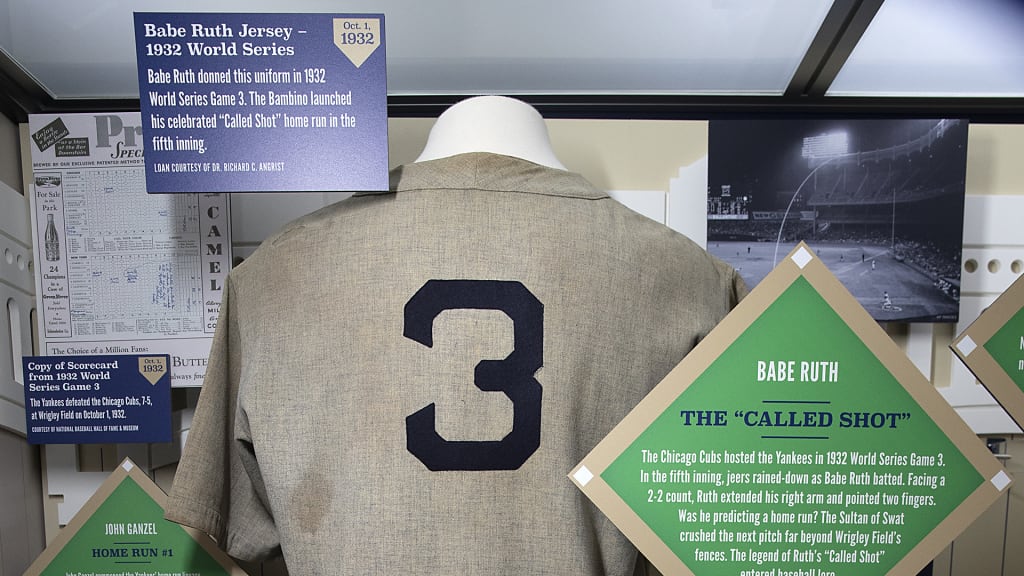
Despite mountains of research and even the discovery of not one, but two 16mm films of the game, whether Ruth actually called his shot remains a source of debate. Of little question, however, is that the road gray uniform currently owned by Angrist and on display at the Yankees Museum is the one Ruth wore when he hit the fabled home run. What also can’t be argued is that the dinger helped the Yankees complete their third World Series sweep in six years.
In 1948’s “The Babe Ruth Story: As Told to Bob Considine,” Ruth called the homer “the most famous one I ever hit,” and pointed out that, most importantly, it did the Yankees some good. “We won that ball game, 7 to 5.”
1934 Japan Tour Jersey
Seeing how Ruth helped explode the game’s popularity, baseball’s stance on offseason exhibition games evolved quite a bit after the unsanctioned 1921 barnstorming tour that earned Ruth and Bob Meusel suspensions to start the ’22 season. By the early 1930s, the league was planning to bring major leaguers across the Pacific to play games against Japan’s best baseball players -- but only if Ruth was involved. “Ruth was paramount to this tour,” said Robert Fitts, author of Banzai Babe Ruth. “They tried for three years to get him. They were hoping to have the tour as early as ’32, but they needed Ruth, and he finally agreed in ’34.”

A group of American League stars -- the NL president barred his players from going -- were expected to play ball against Japan’s finest but also be ambassadors, “a role they took very seriously,” Fitts said. When the Americans suited up for the games, Japanese fans got a look at a familiar sight: Ruth at bat wearing No. 3, with Gehrig, wearing No. 4, kneeling in the on-deck circle. However, it was not the pinstripes or even the Yankees’ road grays that the two legends were dressed in. Ruth, Gehrig and the rest of the AL legends wore special gray uniforms with an “All Americans” patch on the left breast, an interlocking “US” on the left sleeve and cap, and a stars-and-stripes emblem on the right sleeve. Red, white and blue piping along the front and collar, along with red jersey numbers on the back, completed the patriotic look.
Ruth was so fond of his that he wore the jersey on numerous occasions back home. In June of 1939, when the National Baseball Hall of Fame formally inducted its inaugural classes of 1936–39, Ruth donned his All Americans jersey during an exhibition game at Doubleday Field in Cooperstown, New York. Currently being used for the Hands On History program, it is a stunning garment, and just one more reason to make the pilgrimage to the Yankees Museum.
Nathan Maciborski is the executive editor of Yankees Magazine. This story appears in the September 2021 edition. Get more articles like this delivered to your doorstep by purchasing a subscription to Yankees Magazine at www.yankees.com/publications.